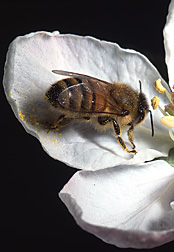This page has been archived and is being provided for reference purposes only. The page is no longer being updated, and therefore, links on the page may be invalid.
Honey Bees with Colony Collapse Disorder Show their Genes
By Kim KaplanAugust 24, 2009
The first hard evidence of what is happening physiologically inside bees during Colony Collapse Disorder (CCD) has been published in a new study by Agricultural Research Service (ARS) and University of Illinois scientists in the Proceedings of the National Academy of Sciences. The study also looked at differences in activity levels of critical genes in CCD and healthy bee colonies.
Using a tool called a genome-wide microarray, the scientists found a large amount of abnormal ribosomal RNA (rRNA) fragments in the guts of honey bees in CCD colonies. Ribosomes are the cellular factories in which proteins are made, guided by rRNA, and a large amount of abnormal rRNA fragments means the protein construction system is compromised. This indicates that honey bees in colonies diagnosed with CCD had reduced ability to synthesize new proteins.
The gut is the primary entry point for pathogens and pesticides in honey bees. Honey bees' stress response systems also can be measured in the bee's gut. The honey bee has two separate response systems: one to environmental stresses such as pesticides, and a different one reacting to pathogens such as viruses.
This was the first time RNA levels have been measured in honey bees as a way of tracking whether it is honey bees' pesticide response system or their pathogen immune response system that is reacting in CCD, according to ARS geneticist Jay Evans, who works in the Bee Research Laboratory at the ARS Henry A. Wallace Beltsville (Md.) Agricultural Research Center. Evans was part of a team that included entomologists May R. Berenbaum, Reed M. Johnson and Gene E. Robinson from the University of Illinois.
In CCD colonies, the genes involved in the pathogen/immune response systems showed no single clear pattern of activity, although there was commonly more activation of these genes and the bees had a higher overall level of viruses and other pathogens than non-CCD colonies.
Almost all CCD colonies had a higher level of picorna-like viruses, which attack the ribosome. Picorna-like viruses that attack honey bees include deformed wing virus and Israeli acute paralysis virus. The varroa mite, a major honey bee parasite, is known to transmit picorna-like viruses.
Bees in CCD colonies did not show significantly active pesticide response genes.
The loss of ribosomal function would explain many of the phenomena associated with CCD, according to Berenbaum. If the bees' ribosomes are compromised, then they can't overcome exposure to pesticides, fungal infections or bacteria or inadequate nutrition because the ribosome is central to the survival of any organism.
The study did not establish a direct cause-and-effect link between the abnormal rRNA and CCD. But colony surveillance by assays of rRNA and other markers expressed by bees could provide the earliest indication of CCD found so far, perhaps in time for beekeepers to take actions that might reduce losses, Evans suggested.
ARS is the principal intramural scientific research agency of the U.S. Department of Agriculture.

